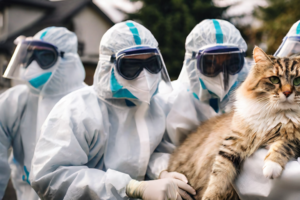 Bubonic Plague: The first human case since 2015 is confirmed by Oregon health officials. Beware of Cats! Deschutes County, Oregon officials report that no new instances of plague have surfaced. Health authorities said this week that an Oregonian has contracted the bubonic plague, the state’s first case since 2015. According to a news release issued on Wednesday by Deschutes County Health Services, the resident’s ill pet cat was probably the source of their plague infection. Deschutes County health officer Dr. Richard Fawcett stated in the announcement, “All close contacts of the resident and their pet have been contacted and provided medication to prevent illness,” without naming the afflicted resident.
Bubonic Plague: The first human case since 2015 is confirmed by Oregon health officials. Beware of Cats! Deschutes County, Oregon officials report that no new instances of plague have surfaced. Health authorities said this week that an Oregonian has contracted the bubonic plague, the state’s first case since 2015. According to a news release issued on Wednesday by Deschutes County Health Services, the resident’s ill pet cat was probably the source of their plague infection. Deschutes County health officer Dr. Richard Fawcett stated in the announcement, “All close contacts of the resident and their pet have been contacted and provided medication to prevent illness,” without naming the afflicted resident.
Since the case was discovered and treated when the illness was still in its early stages, officials stated that there was no risk to the population. No new plague cases have surfaced in the course of the examination into communicable diseases.
What’s the Recent Buzz in Oregon’s Health Scene?
An Oregon resident contracts bubonic plague, the state’s first case since 2015, raising concerns.
How Did the Infection Occur?
The infection likely stems from contact with a symptomatic pet cat, highlighting potential interspecies transmission.
What’s the Health Department’s Take on the Situation?
Deschutes County Health Services swiftly acts, distributing preventive medication to close contacts to contain potential spread.
What’s the Risk to the Community?
Minimal community risk is reported due to early detection and treatment, but ongoing monitoring is crucial.
Understanding the Progression of Bubonic Plague

Bubonic plague can escalate into severe forms if not treated promptly, necessitating vigilance.
When Was the Last Encounter with Plague in Oregon?
The last Oregon case was in 2015, indicating sporadic occurrences rather than regular outbreaks.
What Are the Telltale Signs of Bubonic Plague?
Recognizable symptoms include fever, nausea, and swollen lymph nodes, prompting early medical attention.
How Does Bubonic Spread?
Transmission occurs through flea bites or contact with infected animals, necessitating preventive measures.
Which Animals Harbor Plague?
Squirrels, chipmunks, and rodents are common carriers, requiring focused surveillance efforts.
The Role of Fleas and Rodents in Plague Transmission
Fleas and rodents perpetuate the plague cycle, emphasizing the importance of pest control.
Central Oregon’s Wildlife: A Potential Hotbed for plague
Central Oregon’s wildlife poses a significant risk, warranting targeted intervention strategies.
Lessons from History: Controlling Plague
Historical insights inform present-day approaches to disease control, emphasizing preparedness.
Navigating Public Health Challenges in Oregon
Oregon health agencies collaborate to manage the situation effectively, ensuring public safety.
Future Outlook: Anticipating and Preventing Outbreaks
Proactive measures and ongoing surveillance are key to preventing future outbreaks and safeguarding communities.
 While the recent bubonic plague case in Oregon raises concerns, prompt action and collaborative efforts mitigate community risk, underlining the importance of proactive health measures.
While the recent bubonic plague case in Oregon raises concerns, prompt action and collaborative efforts mitigate community risk, underlining the importance of proactive health measures.
FAQs:
-
Q: Is bubonic plague still a threat in the modern world?
- A: Yes, though rare, bubonic plague remains a concern, necessitating continued vigilance.
-
Q: Can pets transmit bubonic plague to humans?
- A: Yes, pets can transmit the plague through bites or close contact, highlighting the need for awareness.

- A: Yes, pets can transmit the plague through bites or close contact, highlighting the need for awareness.
-
Q: What should I do if I suspect bubonic plague exposure?
- A: Seek medical attention immediately if you suspect exposure and inform healthcare providers for timely intervention.
-
Q: How effective are preventive medications against bubonic plague?
- A: Preventive medications significantly reduce the risk of developing bubonic if administered promptly after exposure.
-
Q: Are there ongoing efforts to monitor bubonic plague in wildlife populations?
- A: Yes, health authorities continually monitor wildlife to detect and prevent bubonic outbreaks.
6. Is Oregon Facing a New Bubonic Plague Scare?
- In a startling revelation, health officials announced the first case of bubonic in Oregon since 2015. But what’s the source of this ancient disease’s resurgence?
7. Could Your Furry Friend Carry the Plague?
- Shocking as it sounds, it’s believed that a pet cat could have transmitted the plague to its owner in Oregon. How common is this scenario, and what precautions should pet owners take?
8. Who’s at Risk in Deschutes County?
- With the infected resident and their pet receiving treatment, officials reassure the community. But what measures are in place to contain the spread, and is there cause for concern?
9. How Deadly Can the Plague Get?
- From bubonic to septicemic and pneumonic plague, the disease can take various dangerous forms. What are the symptoms, and how crucial is early diagnosis and treatment?
10. Is Oregon Facing a Plague Revival?
- The state hasn’t seen a human plague case since 2015, according to health authorities. What factors contribute to outbreaks, and could this be the beginning of a new trend?
11. Are You Familiar with Plague Symptoms?
- Knowing the signs could save lives. But how quickly do symptoms manifest, and what distinguishes them from common ailments?
12. Beware the Tiny Culprits: Fleas and Rodents
- It’s not just cats; squirrels, chipmunks, and rodents can harbor the plague too. How can we protect ourselves from these unsuspecting carriers?
